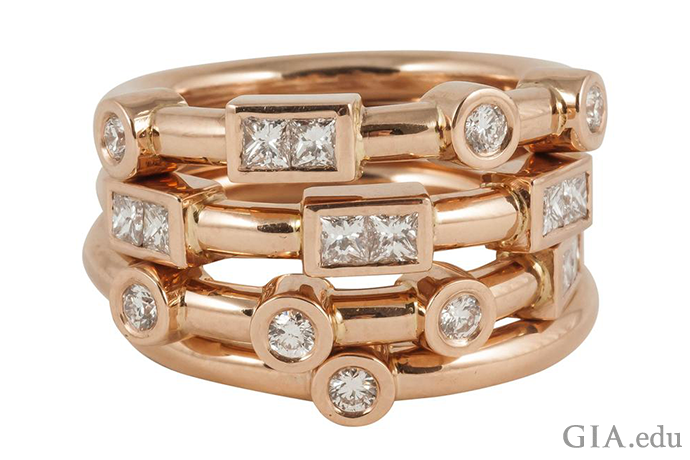Tips for Buying an Engagement Ring
Planning to buy a diamond engagement ring? You’ll need to know the 4Cs, how to pick a diamond shape and cut, metal characteristics, types of settings and more.
Follow these tips for buying an engagement ring to make a smart purchase!
Are you looking to buy an engagement ring? Here are several things you need to know before you begin your search!
1. Know the 4C's
- Color: D-to-Z diamond color grades rate a diamond’s lack of color. Diamonds with less color are rarer.
- Cut: The quality of a diamond’s cut determines how well it unleashes its light.
- Clarity: Diamond clarity refers to the absence of inclusions and blemishes.
- Carat Weight: Diamond carat weight determines a diamond’s apparent size.
2. Understand the difference between diamond shapes, diamond cutting styles, and cut qualities!
Shape describes a diamond’s outline when viewed face up. By far, the most popular diamond shape is round. But there are other shapes—known as fancy shapes—which include the marquise, pear, oval, rectangle, square and heart.
Cutting style refers to how the diamond’s facets are arranged. For example, the most common facet arrangement for round diamonds is the standard brilliant cutting style
Cut quality refers to how well a diamond’s facets interact with light. Diamonds cut in the same shape and style can vary in table size, girdle thickness, polish and symmetry.
3. Pick a metal for the band
If you love the color of gold, consider that white metal prongs or bezels are often integrated into yellow gold bands to create contrast with the diamond. Rose gold is trending, has a warm and soothing appearance. Platinum is a gray-white metal that is elegant, extremely durable and corrosion resistant. Sterling silver is often used in jewelry but rarely in engagement rings, as it is not the most durable of metals and tarnishes over time.
4. Choose the setting
Here are three common types of settings:
1. Prong: A diamond is held in place with four to six prongs (narrow metal supports). When prongs are used to secure a single stone, the ring is often called a “solitaire.”
2. Bezel: For this engagement ring setting style, a thin metal strip is pushed or hammered around the gem to hold it in place. The bezel setting provides excellent protection for the center stone.
3. Halo: Tiny diamonds encircle the center stone. A halo can add more sparkle to an engagement ring and make the center stone look larger.
5. Pick side stones
Side stones are a dazzling way to dress up an engagement ring. Popular choices include channel or pavé set diamonds along the shank of the ring, diamond baguettes on either side of the center stone, and colored gems in any number of configurations.
6. Look at the diamond under different lighting conditions
When buying a diamond engagement ring, be sure to look at it under these four different lighting conditions to see how it performs:
1. An environment where spot lighting is not overwhelming
2. Diffused lighting—fluorescent lights that bounce light off a white ceiling are best
3. A mixed lighting environment of spot and diffused lighting
4. Natural daylight – directly under the sun, or under the dappled shade of a tree that breaks up the diamond’s light into thousands of slivers
7. Pick a trusted jeweler
Since an engagement ring is an expensive purchase, you’ll want to buy it from a jeweler you can trust. Tip – start by looking for a jeweler who has earned a credential from an accredited school like GIA. At Gem Source, our professional jeweler is GIA certified and able to offer you a grading report on the diamond of your choice.
8. Insist on a diamond grading report
When buying an engagement ring, insist on a diamond grading report. By giving you the exact quality characteristics of the diamond, the report will remove any uncertainty from your buying decision. The report will also indicate whether the diamond has been treated to enhance its color or clarity.
Pairing Wedding Bands & Engagement - Inspirational Looks
In this blog we cover the hottest new trends in wedding band designs to compliment your already beautiful engagement ring. Read on to learn about stackables, rose gold, and other new trends sparking into the design world this year.
1. Stackable Wedding Bands
Stackable wedding bands are in – and for good reason. It’s a look that’s easy to personalize. It’s a style that can be changed to suit your moods, your outfit, the season and more. It’s also a way to add lots of melee diamonds – and that’s a good thing: The more diamonds on the band, the more diamond sparkle it will have. With so many pluses, it’s no surprise that stackable wedding bands are popular.
2. Rose Gold
Rose gold is a trending wedding band choice. Its warm tones are soothing and serene. Rose gold wedding bands can also make a bold statement when paired with the perennially popular white metals. Another benefit: Rose gold wedding rings complement most skin tones.
3. Vintage
Vintage designs capture the style and glamour of past eras – but have all the excitement that we’ve come to expect from modern creations. Does your engagement ring have a vintage style, like Art Deco, Art Nouveau or Edwardian? Why not carry the style through with your wedding band to create a themed and unified look? Brides-to-be with a taste for things of the past are making this one of the more popular trends for wedding bands.
4. Micro-Pave
Pavé is a setting style where numerous melee diamonds are set into the metal’s surface in a honeycomb pattern, nestled close to the stones next to them. It creates an appearance of uninterrupted diamonds. A field of diamonds is irresistible for its sparkle, and that has made the pavé look one of this year’s hottest trends in wedding bands.





